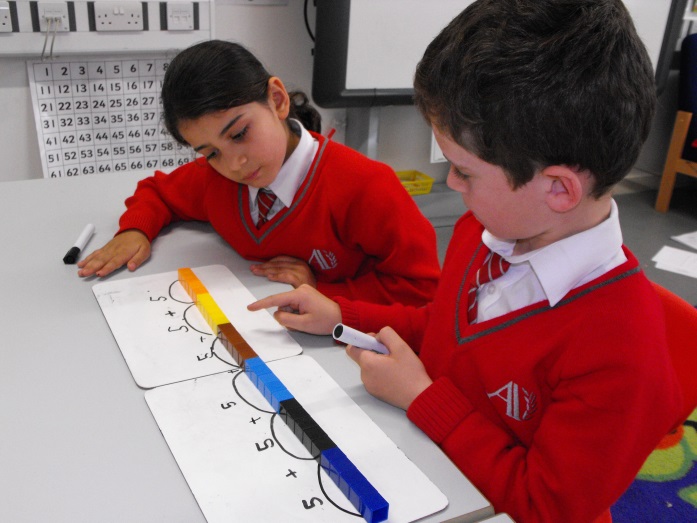
This is my second response blog to the Ofsted Maths review, read my first response on possible missing puzzle pieces – problem solving.
Let’s begin by celebrating the review’s emphasis on conceptual understanding in maths: Core concepts should build seamlessly on knowledge acquired in previous phases. For example, a younger pupil’s knowledge of the concept of ‘balance’ and the way this concept is connected to the equals sign will help them when they encounter linear equations in key stage 3. In an earlier blog, we praise the focus on a well-connected, cumulative and coherent curriculum. But it’s also exciting to read the specifics of the ‘equals sign’. We think this is helpful guidance for teachers on developing depth from an early age. These foundational connections in EYFS - the idea of a balanced equation – are invaluable when working with all sorts of algebra in later years.
Depth of understanding we feel has been rightfully prioritised, nicely echoing Mathematics Mastery’s approach: focus on core knowledge in younger year groups can be achieved by focusing on depth over breath, covering fewer core topics but in more detail. There’s also multiple references to ‘relationships’ – ‘between facts, procedures and missing facts’ and ‘between information, strategies and missing information’. We agree that it’s vital these aspects of maths aren’t taught in isolation…
…But it was surprising not to see reference in the review to Skemp’s influential work on ‘relational understanding’, Askew’s evidence on the success of a connectionist approach on pupil outcomes or Duval’s work mentioned in the last blog about the need for pupils to ‘convert’ between representations to construct meaning and understanding in maths, so I’ve included it below. A few vital ‘maths giants’ who have been sadly missed out again.
Informal methods, some of which may involve physical resources, can be useful for revealing underlying principles and concept. Nicely put! We definitely agree and feel the latter part illustrates the aim of variation in task design. However, we think the review unfortunately misses an opportunity to ‘make a connection’ of its own, to variation theory here and instead focuses on the shortcomings of both representations and mental methods.
Emphasis was placed on the relationships between core facts and methods but overlooked the connections between a) different aspects of mathematics b) different representations of mathematics and c) with and between pupils’ methods and connections. Connections are crucial!
Several studies have found that the long-term use of manipulatives has a positive effect on pupil achievement. Use of concrete objects allows pupils to visualise, model and internalise abstract mathematical concepts. Like problem solving, connections and representations are a central part of our National Curriculum: ‘Mathematics is an interconnected subject in which pupils need to be able to move fluently between representations of mathematical ideas.’
“Manipulatives (concrete materials) and other representations offer powerful support for learners, which may be gradually internalised as mental images take over (Streefland, 1991; Carbonneau et al., 2013). However, teachers need to help learners to link the materials (and the actions performed on or with them) to the mathematics of the situation, to appreciate the limitations of concrete materials, and to develop related mathematical images, representations and symbols (Nunes et al., 2009).”
(Hodgen et al. 2018, page 19).
We’ve interpreted the review as having another ideological mismatch here, between its messaging and what is stated in our National Curriculum above. The power of visual imagery is completely overlooked in preference for another warning in the review: “Even imagery can be distracting: textbooks in countries where pupils do well have fewer non-content related and distracting illustrations, pictures and cartoons” Manipulatives get a hard time too: ‘The use of manipulatives…may distract pupils from thinking about content to be learned’
An entire blog could be dedicated to it! Tough to select one single quote but let’s go for this neat summary:
“…making connections between external representations helps make connections between internal representations. This also suggests that comparing and contrasting representations of the same mathematical relations using different manipulatives can develop understanding.”
Griffiths, Back & Gifford (2017).
It only takes a glimpse into their book ‘Making numbers: Using manipulatives to teach arithmetic’ to reveal the number of approaches available to develop pupils’ understanding of early number.
Manipulatives are not a prop to support children to ‘get the right answer’. Rather, use of multiple representations strengthens conceptual understanding, better preparing children with the foundational knowledge they need to be successful in more advanced mathematics.
Askew, M., Brown, M., Rhodes, V. Johnson, D., William, D. (1997) Effective Teachers of Numeracy: Final Report. Kings College: London
Duval, R. 2006. A Cognitive Analysis of the Problems of Comprehension in a Learning of Mathematics. Educational Studies in Mathematics. 61: 103-131.
Griffiths, Back & Gifford. 2016. ‘Making Numbers: Using manipulatives to teach arithmetic’
Griffiths, Back & Gifford. 2017. Using manipulatives in the foundations of arithmetic: Main Report. University of Leicester.
EEF Guidance Report: Improving Mathematics in Key Stages Two and Three. (November 2017)
Hodgen, J., Foster, C., Marks, R., & Brown, M. (2018). Evidence for Review of Mathematics Teaching: Improving Mathematics in Key Stages Two and Three: Evidence Review. London: Education Endowment Foundation, accessed at: https://educationendowmentfoundation.org.uk/evidence-summaries/evidencereviews/improving-mathematics-in-key-stages-two-and-three/
Skemp, R.R. (1976) ‘Relational understanding and instrumental understanding’. Mathematics Teaching, 77, pp 20-26.
Related Posts